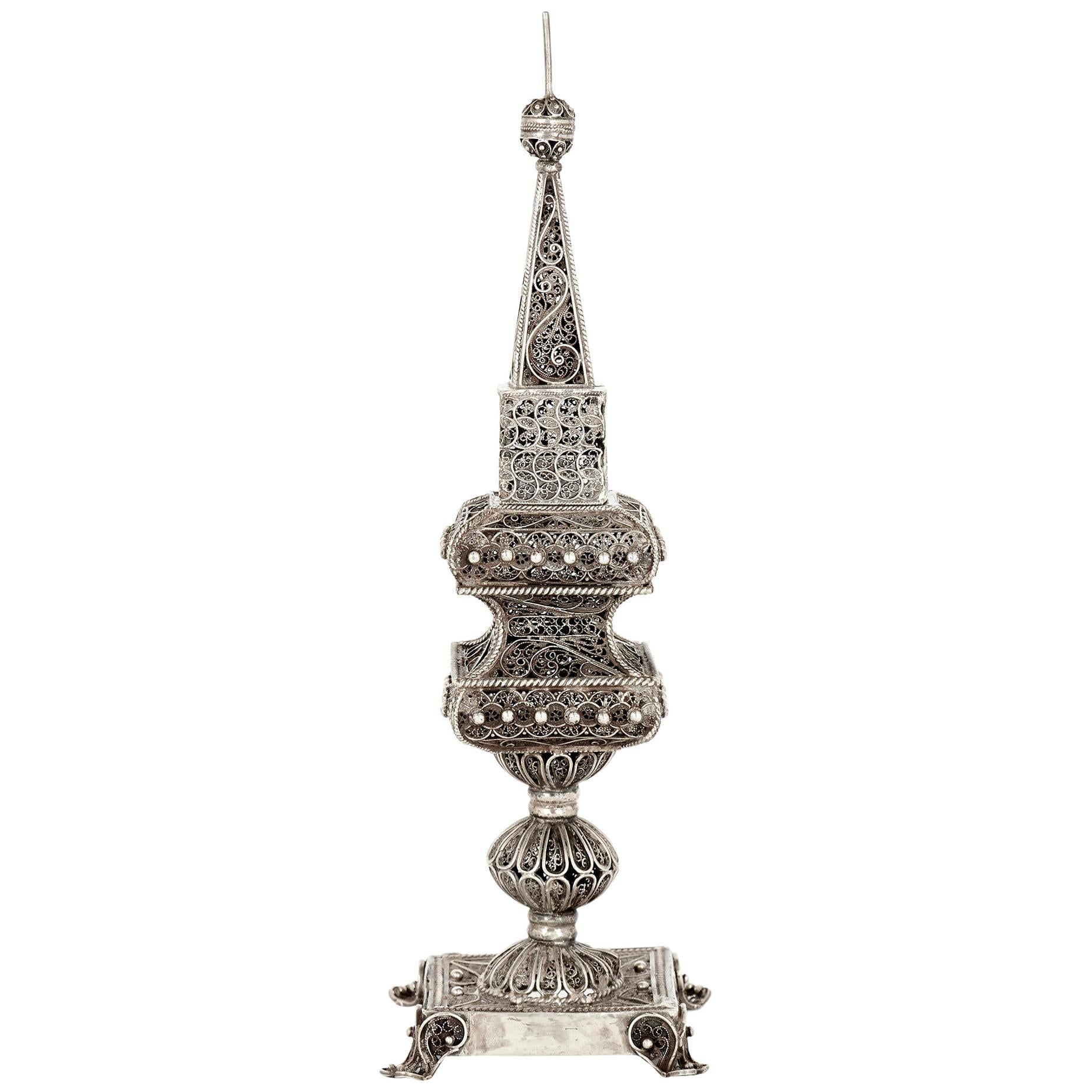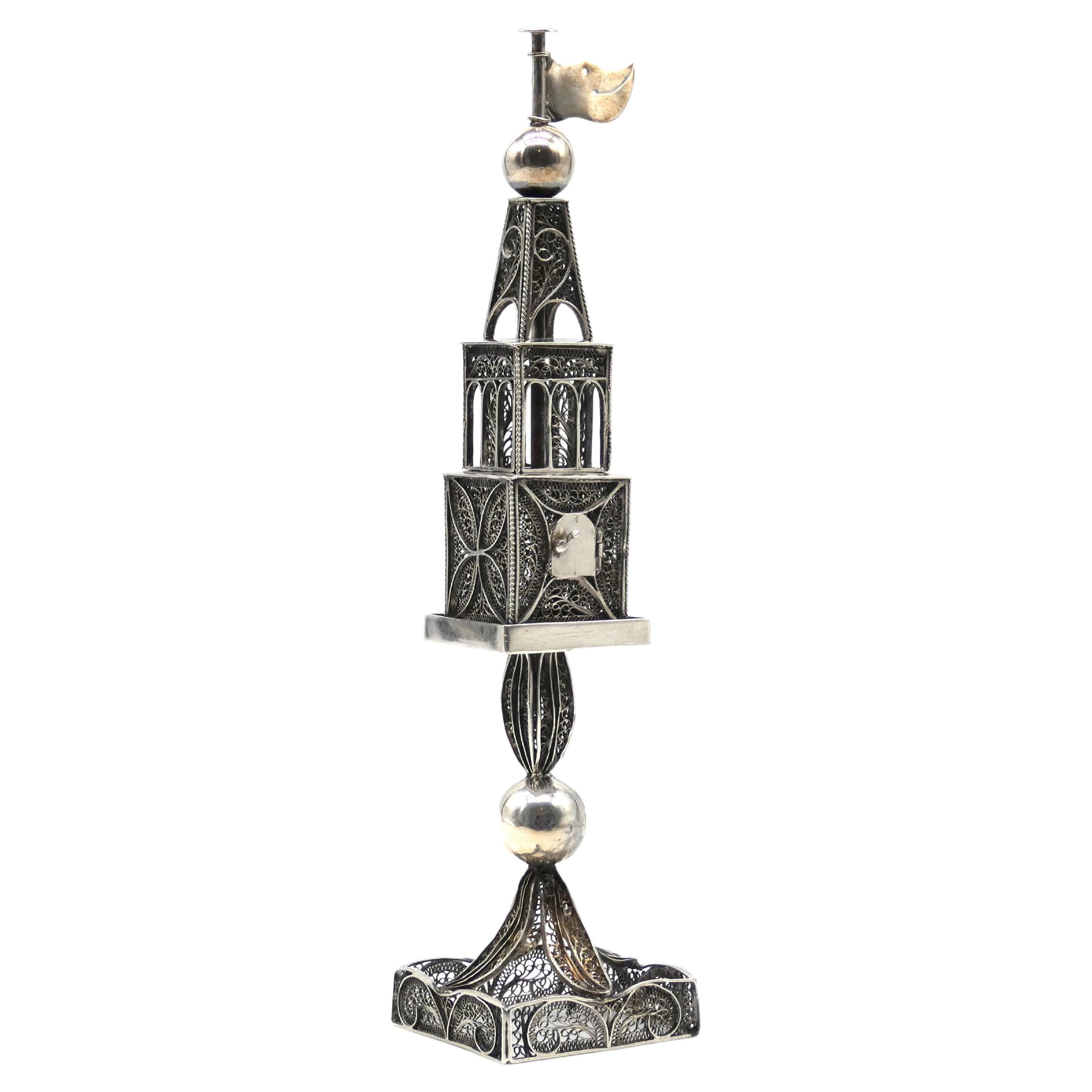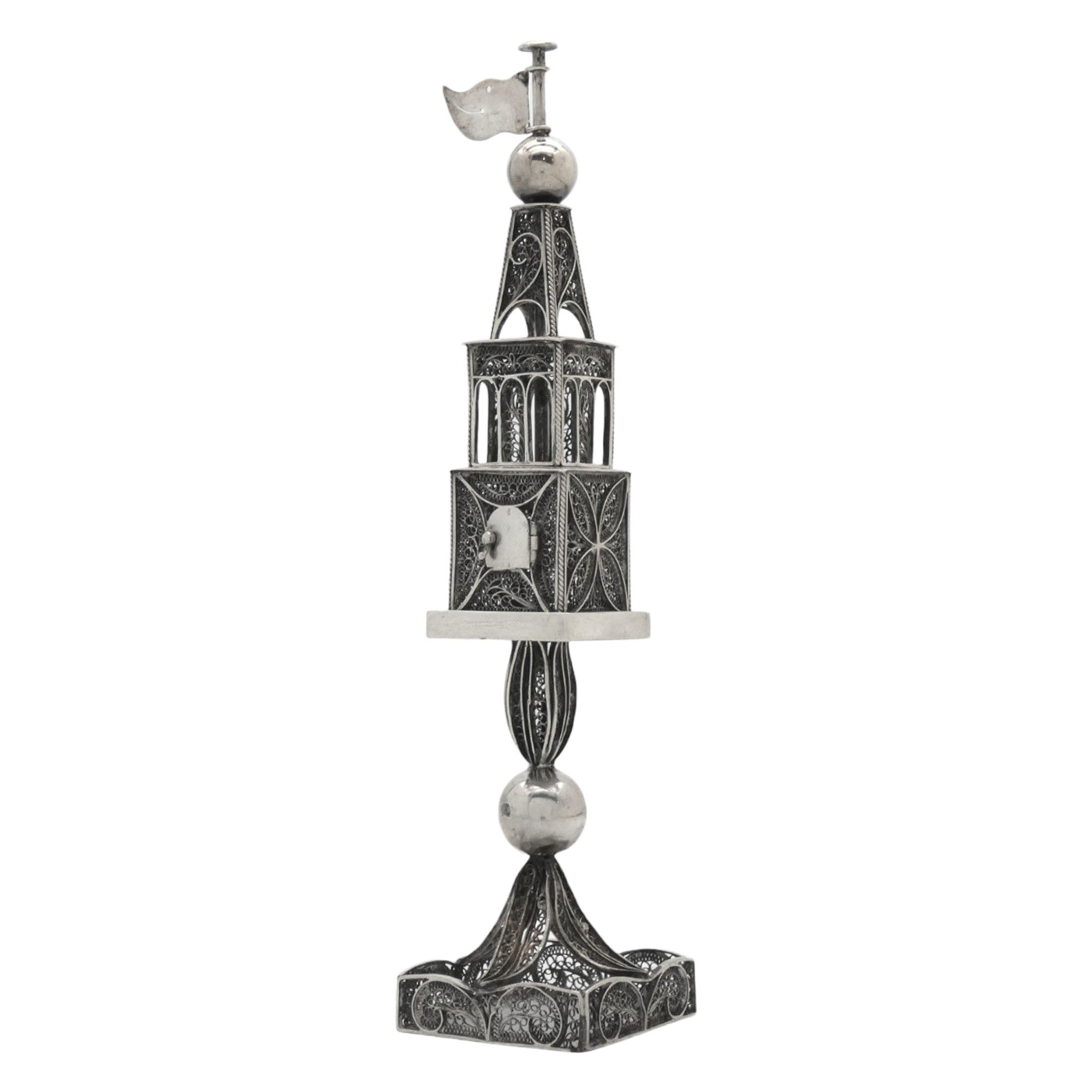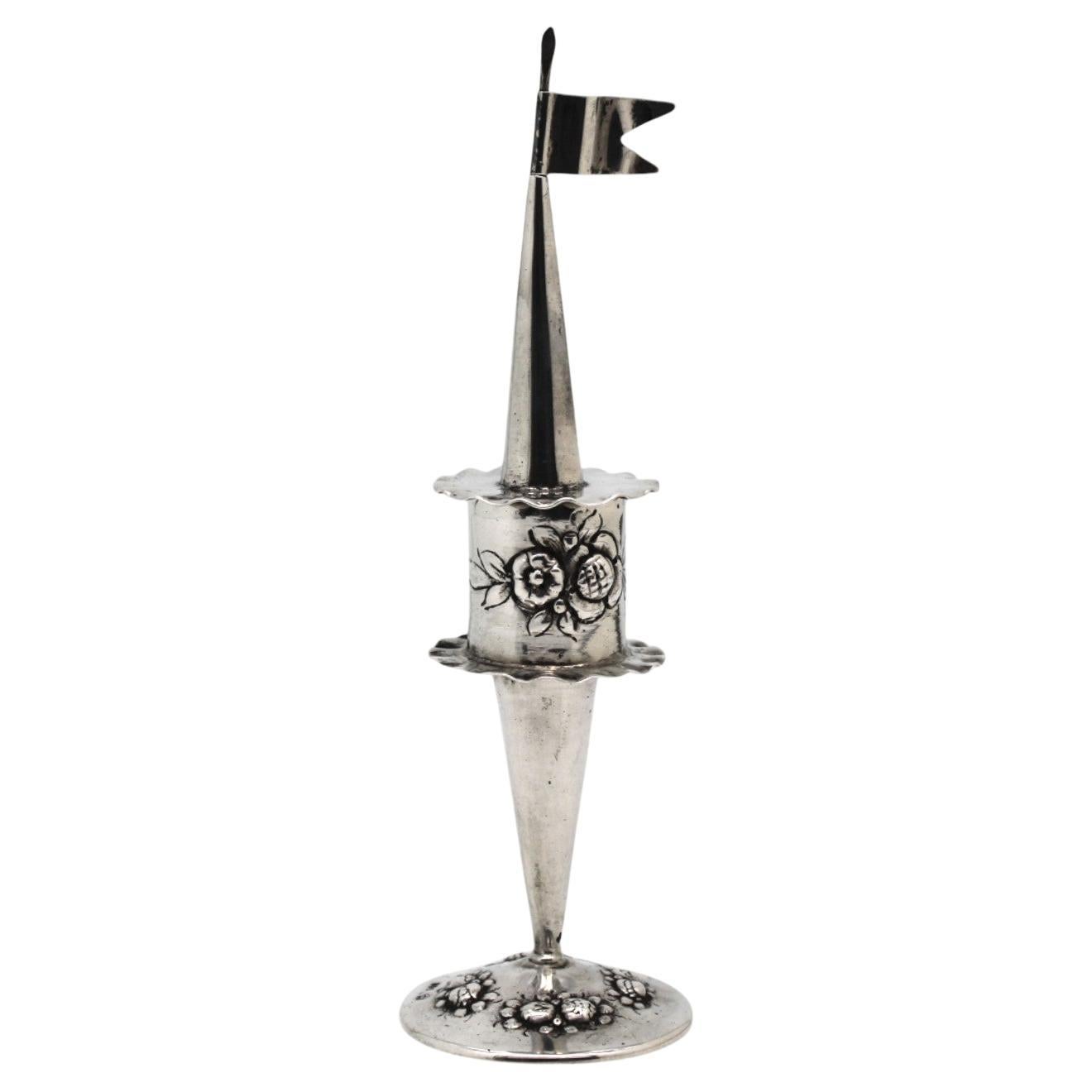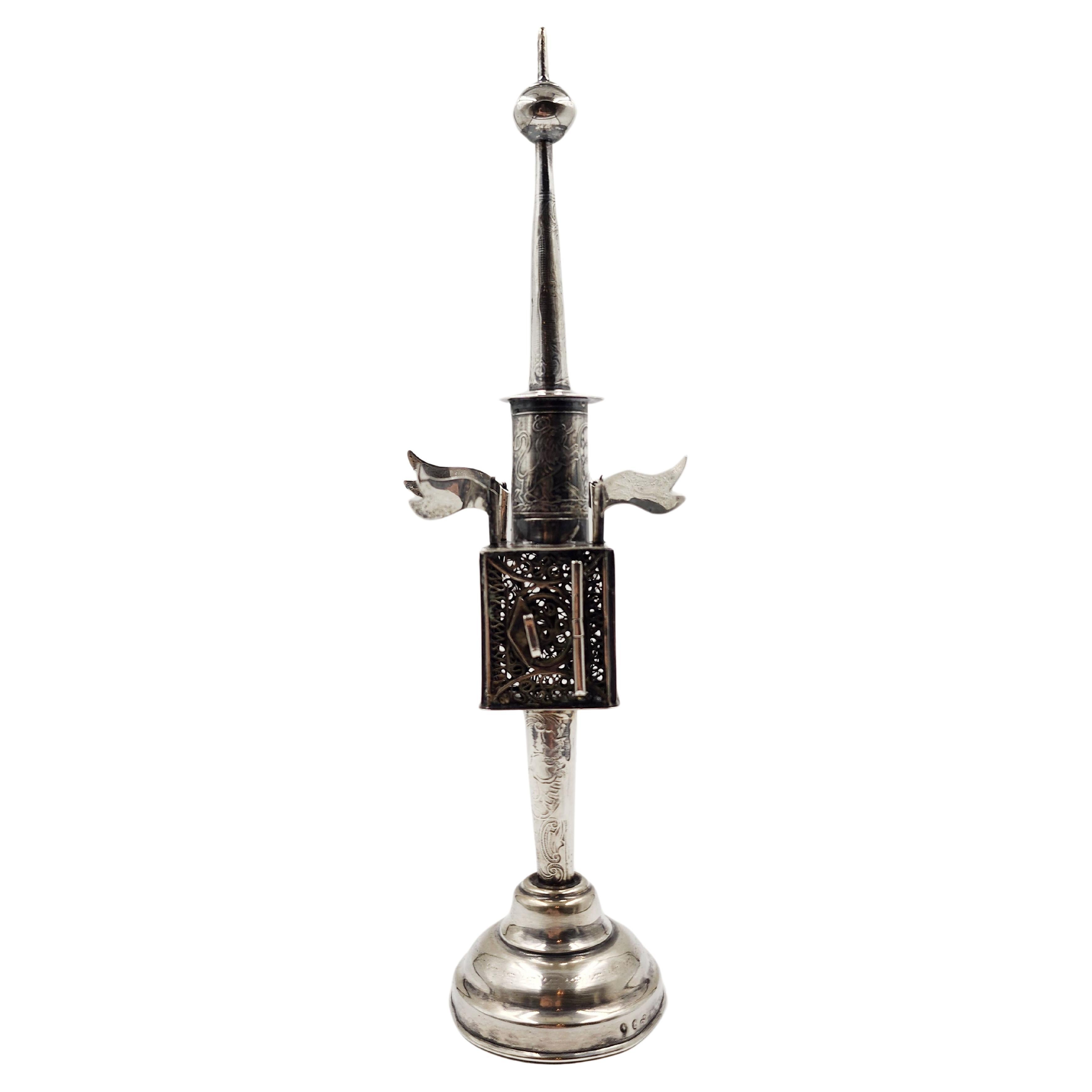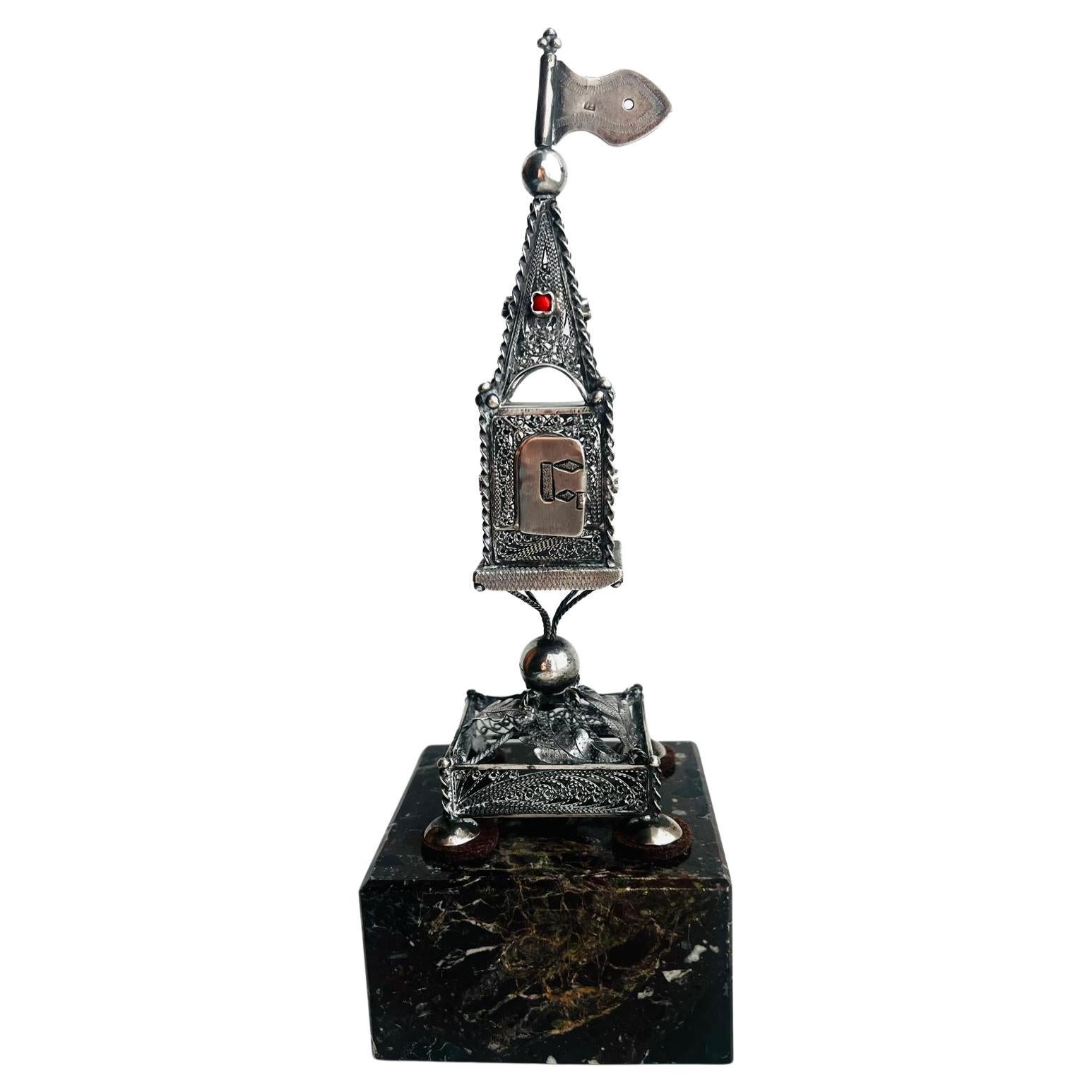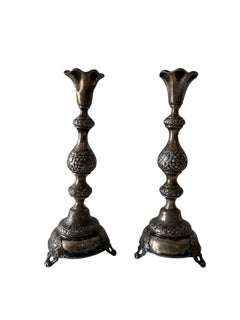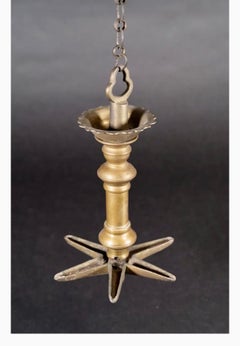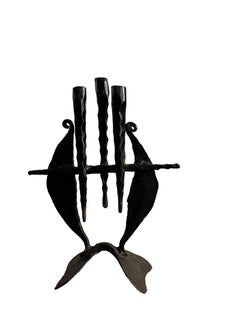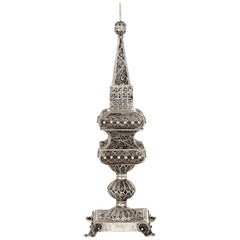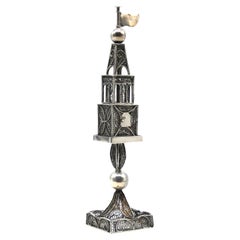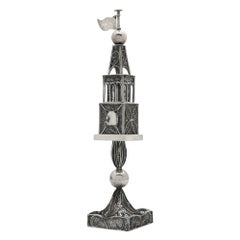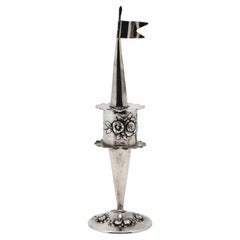Items Similar to Rare 19th C Antique Silver Filigree Judaica Besamim Spice Tower Austro Hungarian
Want more images or videos?
Request additional images or videos from the seller
1 of 13
UnknownRare 19th C Antique Silver Filigree Judaica Besamim Spice Tower Austro Hungarian
$2,600
£1,961.07
€2,265.06
CA$3,642.78
A$4,050.56
CHF 2,120.54
MX$49,478.36
NOK 26,646.70
SEK 25,066.56
DKK 16,908.50
About the Item
An exceptional, fine and impressive antique Austro-Hungarian silver spice tower;
This beautiful box is fitted with a hinged door and is fully hallmarked
The square shaped foot is ornamented with filigree decoration and supported by four plain semi-spherical feet. Judaica silver spice tower, Viennese or Austro Hungarian, 5.5 troy, height is 9.75"
These were used in the Havdalah ceremony marking the close of Shabbat the Jewish Sabbath.
Hallmarked with a silver purity mark and a makers hallmark. My estimation is Vienna but it might be from Poland or Czechoslovakia.
Beginning in the 16th century a common form is that of a tower, influenced by developments in architecture.
Jewish ceremonial art, also known as Judaica refers to an array of objects used by Jews for ritual purposes. Both for synagogue and for home, because enhancing a mitzvah by performing it with an especially beautiful object is considered a praiseworthy way of honoring God's commandments, Judaism has a long tradition of commissioning ritual objects from craftsmen and artists.
Judaism has a set of classical early rabbinic commentaries on the Hebrew Bible; these commentary collections are known as the midrash literature (Heb: midrashim). Midrash Mechilta has this teaching on a biblical verse:
"This is my God and I will glorify Him" (Exodus 15:2)
Is it possible for a human being to add glory to his Creator? What this really means is: I shall glorify God in the way that I perform commandments. I shall prepare a beautiful lulav, beautiful sukkah, beautiful fringes (tzitzit), and beautiful tefilin."
Other Midrash teachings (e.g. Song of Songs Rabbah 1.15) offer the same idea. This idea is expanded upon in the Babylonian Talmud (e.g. Tractate Bava Kama 9b). This teaching was understood by succeeding generations as a duty, when possible, to make beautiful items used in Jewish life and worship, both physical and textual
Kiddush cup: Kiddush, literally, "sanctification," is a blessing recited over wine or grape juice to sanctify the Shabbat and Jewish holidays. Kiddush cups are highly decorated, and are generally made of china, porcelain, silver, pewter and nickel. The close of the Jewish Shabbat is marked by the brief prayer ceremony of Havdalah, which usually takes place in the home. Part of the ceremony requires sniffing a sweet-smelling spice or plant. In Jewish communities around the Mediterranean, a sprig of a sweet-smelling shrub was customarily used, in Northern Europe by the twelfth century there are literary references of the use of a specially designed spice box or or spice tower container. The oldest surviving spice boxes for Havdalah date to the mid-sixteenth century. The Jewish Museum (New York) has a German example c. 1550 thought to originate in Frankfurt am Main. The menorah (or hanukkiah) used on the Jewish holiday of Hanukkah is perhaps the most widely produced article of Judaic ceremonial art. The Lindo lamp is a particularly fine example by an 18th-century silversmith. Contemporary Israel artists often design menorahs, such as the gold-plated brass menorah with 35 moveable branches designed by Israeli artist Yaacov Agam. A silver Chanukah menorah by Ze'ev Raban from the 1930s is in the Judaica Collection of the North Carolina Museum of Art.
To protect the ethrog during the Sukkot holiday, it is traditionally wrapped in silky flax fibers and stored in a special box, often made from silver. In modern times, the etrog is also commonly wrapped in synthetic netting, and placed in cardboard boxes. Wooden boxes are increasingly popular as well.
The tradition of artistically embellished haggadah, the Jewish Hebrew text that sets forth the order of the Passover Seder, dates back to the Middle Ages. The Sarajevo Haggadah of 1350 is a celebrated example. Major contemporary artists have produced notable haggadahs, such as the Arthur Szyk Hagadah. See also the facsimile edition of the even earlier Barcelona Haggadah of 1340.
Museums with notable collections of Jewish ceremonial art include the British Library, the Israel Museum, Jerusalem, as well as the Tel Aviv museum of art, the Jewish Museum (London), the Musée d'Art et d'Histoire du Judaïsme in Paris, the Jewish Museum in Prague, the North Carolina Museum of Art, the Jewish Museum (New York), the Musée Lorraine in Nancy, the Musée alsacien in Strasbourg and the Contemporary Jewish Museum of San Francisco. The Museum of Jewish Heritage in Battery City Park, New York City also holds a sizable collection. Another way to see good antique, rare, Judaica is through the art marketplace, There are many examples of Russian, German Polish, Austro Hungarian and Sephardic works available as well as contemporary Israeli and American. The leading auction houses. Sotheby's, Bonhams-New York, J. Greenstein, Skinner's and Kestenbaum's routinely hold regular auctions each year.
- Dimensions:Height: 9.75 in (24.77 cm)Width: 2.75 in (6.99 cm)Depth: 2.75 in (6.99 cm)
- Medium:
- Period:
- Condition:Please see photos. Condition is commensurate with age and use.
- Gallery Location:Surfside, FL
- Reference Number:1stDibs: LU38215821882
About the Seller
4.9
Platinum Seller
Premium sellers with a 4.7+ rating and 24-hour response times
Established in 1995
1stDibs seller since 2014
1,799 sales on 1stDibs
Typical response time: <1 hour
- ShippingRetrieving quote...Shipping from: Surfside, FL
- Return Policy
Authenticity Guarantee
In the unlikely event there’s an issue with an item’s authenticity, contact us within 1 year for a full refund. DetailsMoney-Back Guarantee
If your item is not as described, is damaged in transit, or does not arrive, contact us within 7 days for a full refund. Details24-Hour Cancellation
You have a 24-hour grace period in which to reconsider your purchase, with no questions asked.Vetted Professional Sellers
Our world-class sellers must adhere to strict standards for service and quality, maintaining the integrity of our listings.Price-Match Guarantee
If you find that a seller listed the same item for a lower price elsewhere, we’ll match it.Trusted Global Delivery
Our best-in-class carrier network provides specialized shipping options worldwide, including custom delivery.More From This Seller
View AllRare 19th C. Antique Silver Judaica Shabbat Candlesticks Polish Russian, Szekman
Located in Surfside, FL
An exceptional, fine and impressive antique Austro-Hungarian Antique Judaica Pair of Shabbos hallmarked silver candlesticks, 12" tall, 16 troy
Dated 1895
Viennese or Austro Hungaria...
Category
Late 19th Century Rococo Mixed Media
Materials
Silver
Rare Antique Judaica Hanging Bronze Jewish Synagogue or Temple Oil Lamp w Chain
Located in Surfside, FL
Judaica Shabbat Continental Hanging Solid Brass Oil Lamp with Central Six Pointed Jewish Star Shaped Body Dimensions Approx: with Chain 23"H x 8
11 x 8 x 8 chain is 22" long
Antique...
Category
19th Century Other Art Style More Art
Materials
Brass, Bronze
French Brutalist Silvered Cast Bronze Sculpture Lamp Pierre Casenove Fondica Art
Located in Surfside, FL
Pierre Casenove (French)
Silver patina bronze table lamp having a column form and various stamped patterns to the body, stamped signed mark to back of bas...
Category
1990s Post-Modern Abstract Sculptures
Materials
Metal
Brutalist Hand Forged Iron Sculpture Candelabra Candle Stick Israeli Art Palombo
By David Palombo
Located in Surfside, FL
Hand Forged Iron Sconce Candelabra
Holocaust Memorial Judaic table Sconce Sculpture
David Palombo was an Israeli sculptor and painter. He was born in Turkey to a traditional family and immigrated to the Land of Israel with his parents in 1923. They lived in the Nahalat Shiva neighborhood of Jerusalem. In 1940 he began his studies at Bezalel Academy of Arts and Design, and from 1942 was a student of sculptor Ze’ev Ben-Zvi. For a period of time, Palombo was an assistant at Ben-Zvi’s studio and also taught at Bezalel. During this period he was also a member of the “Histadrut HaNoar HaOved VeHaLomed” (The General Federation of Students and Young Workers in Israel). In the 1940s he took art lessons at night. In 1948 he went to Paris, where he visited the studio of the sculptor Constantin Brancusi whose work influenced him. Around 1958 he married the artist Shulamit Sirota. In 1960 he quit his job to devote himself to art. In 1964 he married for the second time to the artist Yona Palombo. The two of them went to live in an abandoned home on Mount Zion in Jerusalem. In 1966 he was killed when the motorcycle on which he was riding ran into a chain stretched across the street to prevent the desecration of Shabbat. His widow opened a museum in their home that was active until the year 2000.
Work by Palombo is included in the Judaic collection of the Jewish Museum (a well known Hanukkah menorah). Palombo executed the impressive metal gates of the Tent of Remembrance at the Yad Vashem, the memorial to the martyrs of the holocaust, as well as the gates to the Knesset Building the United Nations Educational Scientific and Cultural Organization (Unesco award) awarded him a scholarship for study in Japan. He worked in marble, granite, bronze, iron and steel. as well as with glass mosaic tiles. Palombo’s early works, in the 1950s, were influenced by modernist sculptors such as Brancusi. These works were composed of abstract images from nature and were carved out of stone or wood. At the end of the 1950s he began making metal sculptors, using the technique of welding. His work took on a more abstract and expressive character.
Education
1940 Painting with Isidor Ascheim, New Bezalel School for Arts and Crafts, Jerusalem
1942 Sculpture with Zeev Ben Zvi, Jerusalem
1956 Mosaic, Ravenna, Italy
1958 Welding Course
Awards And Prizes
1966 UNESCO Award
Exhibitions:
Sculpture in Israel, 1948-1958 Mishkan Museum of Art, Kibbutz Ein Harod
Artists: Zvi Aldouby, Yitzhak Danziger, Arieh Merzer, Dov Feigin, Aaron Priver, David Palumbo, Menashe Kadishman, Kosso Eloul, Yehiel Shemi, Zahara Schatz.
The Spring Exhibition of Jerusalem Artists, Artists' House, Jerusalem
Artists: Palombo, David Bezalel Schatz, Mordechai Levanon, Fima, Ludwig Blum
12 Artists, The Bezalel National Museum, Jerusalem
Avraham Ofek, Aviva Uri, Avigdor Arikha, Yosl Bergner, Lea Nikel, Palombo, Ruth Zarfati...
Category
Mid-20th Century Arte Povera Abstract Sculptures
Materials
Iron
Bronze Architectural Model Sculpture Tempio Bretton Architecture Maquette
Located in Surfside, FL
TEMPIO BRETTON: from the catalogue MONUMENTA, 19th International Sculpture Biennale, Antwerp, Belgium.
Tempio Bretton was created in homage to the celebrated English landscapist Capability Brown for the occasion of an exhibition at Bretton Hall in the Yorkshire Sculpture Park , a park in the style of the great master of English garden design. The inclusion in the English garden of a temple ruin, or "eye-catcher," (architectural folly) was used to draw the eye and mind to a focus in time and space, present the beholder with an immediate relationship to an historic past made new within his or her own surroundings, and create a depth of space never before seen in garden design.
I took the idea of the temple ruin eye-catcher and reduced it to a scale at the point where architecture and sculpture merged. Tempio Bretton is not capacious enough to walk into, yet it is considerably larger than a man.
One view of it presents a knot of golden columns clustered together, topped by a dome shape. The only clue from this side to the temple's non-conformity to historic principle is a sharp notch cut into the square base.
Viewed from the opposite side, the cluster of columns capped by an angular top opens up as if to welcome someone in, yet the mysterious core is still impenetrable. These contradictions articulate a confrontation between past and present, and an exciting truth. The past is always at the heart of our constructions in the present.
Walter Dusenbery (born September 21, 1939 in Alameda, California) is an American sculptor. He attended the San Francisco Art Institute, earned an MFA from California College of Arts and Crafts, and then studied in Japan and Italy under Isamu Noguchi. He also held teaching positions at Harvard University and University of California, Berkeley Graduate School of Design. From 1971 to 1988, he lived both in Pietrasanta,Italy, and in Little Italy, New York City. Dusenbery's preferred material is stone, particularly travertine or granite. Dusenbery has a particular interest in adding sculpture to public places, such as federal buildings, to humanize the space, but in 1988, he assembled a show of small, entirely hand-carved alabaster sculptures, called "Walter Dusenbery, The Personal Side," at the Fendrick Gallery in Washington, D.C.. In 1977, Dusenbery created Pedogna, on permanent loan from The Metropolitan Museum of Art to Landmarks, the public art program of The University of Texas at Austin.
That same year, 1988, he was awarded a large commission for the Fulton County Building Atrium in Atlanta, Georgia. The commission was for three fountains and related structures over three stories in height, designed for informal and ceremonial public events, Limestone, marble, granite and travertine fountains, pavilions, seating and meeting areas, performance and concert platforms, staircases and planters for hanging gardens. After completion of the "Atlantacropolis," Dusenbery withdrew from the gallery world and focused his energy on site-specific commissions. (like the landscape works of Maya Lin and Beverly Pepper) Seeking a large-scale stone studio for projects closer to home, he discovered there were none. In 1995, he approached sculptor and patron of sculpture J. Seward Johnson Jr. with the idea of creating a state-of-the-art stone-carving studio, so that American sculptors would not have to travel abroad to realize their work. Johnson agreed to fund such a facility, if Dusenbery would direct it. In 1996, Dusenbery designed the facility for the Stone Division at Johnson Atelier Technical Institute of Sculpture, and was its first director. The facility was situated in "a building resembling an airplane hangar," The studio offered the ability to digitally scan three-dimensional forms. The Stone Division was a success and attracted a strong group of sculptors: Magdalena Abakanowicz, Lawrence Argent, Barry X Ball...
Category
20th Century American Modern Abstract Sculptures
Materials
Bronze
Mid Century Brutalist Iron Sculpture, Israeli Master David Palombo
By David Palombo
Located in Surfside, FL
Hand Forged Iron Candelabra
Holocaust Memorial Judaic Menorah Sculpture
David Palombo was an Israeli sculptor and painter. He was born in Turkey to a traditional family and immigrated to the Land of Israel with his parents in 1923. They lived in the Nahalat Shiva neighborhood of Jerusalem. In 1940 he began his studies at Bezalel Academy of Arts and Design, and from 1942 was a student of sculptor Ze’ev Ben-Zvi. For a period of time, Palombo was an assistant at Ben-Zvi’s studio and also taught at Bezalel. During this period he was also a member of the “Histadrut HaNoar HaOved VeHaLomed” (The General Federation of Students and Young Workers in Israel). In the 1940s he took art lessons at night. In 1948 he went to Paris, where he visited the studio of the sculptor Constantin Brancusi whose work influenced him. Around 1958 he married the artist Shulamit Sirota. In 1960 he quit his job to devote himself to art. In 1964 he married for the second time to the artist Yona Palombo. The two of them went to live in an abandoned home on Mount Zion in Jerusalem. In 1966 he was killed when the motorcycle on which he was riding ran into a chain stretched across the street to prevent the desecration of Shabbat. His widow opened a museum in their home that was active until the year 2000.
Work by Palombo is included in the Judaic collection of the Jewish Museum (a well known Hanukkah menora). Palombo executed the impressive metal gates of the Tent of Remembrance at the Yad Vashem, the memorial to the martyrs of the holocaust, as well as the gates to the Knesset Building the United Nations Educational Scientific and Cultural Organization (Unesco award) awarded him a scholarship for study in Japan. He worked in marble, granite, bronze, iron and steel. as well as with glass mosaic tiles. Palombo’s early works, in the 1950s, were influenced by modernist sculptors such as Brancusi. These works were composed of abstract images from nature and were carved out of stone or wood. At the end of the 1950s he began making metal sculptors, using the technique of welding. His work took on a more abstract and expressive character.
Education
1940 Painting with Isidor Ascheim, New Bezalel School for Arts and Crafts, Jerusalem
1942 Sculpture with Zeev Ben Zvi, Jerusalem
1956 Mosaic, Ravenna, Italy
1958 Welding Course
Awards And Prizes
1966 UNESCO Award
Exhibitions:
Sculpture in Israel, 1948-1958 Mishkan Museum of Art, Kibbutz Ein Harod
Artists: Zvi Aldouby, Yitzhak Danziger, Arieh Merzer, Dov Feigin, Aaron Priver, David Palumbo, Menashe Kadishman, Kosso Eloul, Yehiel Shemi, Zahara Schatz.
The Spring Exhibition of Jerusalem Artists, Artists' House, Jerusalem
Artists: Palombo, David Bezalel Schatz, Mordechai Levanon, Fima, Ludwig Blum
12 Artists, The Bezalel National Museum, Jerusalem
Avraham Ofek, Aviva Uri, Avigdor Arikha, Yosl Bergner, Lea Nikel, Palombo, Ruth Zarfati,
General Exhibition, Art in Israel 1960 Tel Aviv Museum of Art
Artists: Naftali Bezem, Nachum Gutman, Shraga Weil, Shraga, Marcel Janco, Ruth Schloss
Category
Mid-20th Century Arte Povera Abstract Sculptures
Materials
Iron
You May Also Like
Silver Filigree Judaica Spice Tower
Located in London, GB
The body of this large spice tower is decorated all over with fine filigree work, wrought into scrolled and geometrical designs. The tower, supported by a ...
Category
20th Century European Religious Items
Materials
Silver
$4,965 Sale Price
20% Off
Unusual Silver Filigree Spice Tower , Austria circa 1880
Located in New York, NY
Spice tower has a square base with a filigree leaf designed stem branching upward and encompassed with a ball in center. Spice container is square shaped with a floral design in the ...
Category
Antique 1880s Austrian Sterling Silver
Materials
Silver
$3,600 Sale Price
20% Off
A Silver and Filigree Spice Tower, Austria 1880
Located in New York, NY
An exquisite example of masterful silversmithing, this Austrian spice tower is crafted of silver and intricate silver filigree, showcasing remarkable artistry and fine attention to d...
Category
Antique 1880s Austrian Sterling Silver
Materials
Silver
A Silver Havdalah Spice Tower, Germany Circa 1900
Located in New York, NY
This exquisite German silver Havdalah spice container, crafted circa 1900, is a refined example of early 20th-century Judaica, blending delicate craftsmanship with elegant form. The ...
Category
Antique Early 1900s German Sterling Silver
Materials
Silver
Spice TowerJudaica in Silver, 20th Century
Located in Autonomous City Buenos Aires, CABA
Spice Tower in Judaic Silver, 20th Century
A beautiful spice tower of typical design, with four flags, the tower is topped with a small ball. Set on a round leg. Decorated with filig...
Category
20th Century European Art Deco Sheffield and Silverplate
Materials
Silver Plate
Antique Rare Judaica Silver Spice Tower 18th century Germany
Located in Doha, QA
This is an extremely rare and absolutely magnificent filigrane made 18th century silver spice tower. It has been crafted in Germany and hallmarked in two places with number 12. The German and Austrian hallmark in the 18th century, which was called Lot/ Loth and was used to indicate proportion of precious metal content in any metal object.
The base of the tower is square and has an intricate ornamented leaf design, the silver ball connects the base and the main part of the tower. In the middle there is a
small movable door which opens to the outside and has an engraved Hebrew letter Tav in an old font. It’s the last letter of the Hebrew Alphabet and translates as “truth”.
It symbolises truth, perfection, and completion. The tower has six gemstones on it, four red and two dark green. The design remains filigrane and fragile from the bottom to the top on all sides and at the tip of the tower there is a flag in an arrow shape.
This rare spice tower is impressive and very finely crafted. The condition for its age is excellent. The tower comes together with a beautiful original art deco wooden leather box...
Category
Antique Late 18th Century German Religious Items
Materials
Silver
